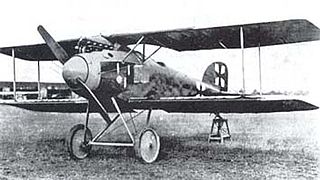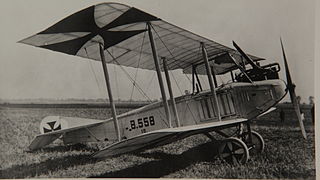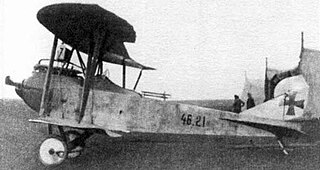
The Albatros D.II was a German fighter aircraft used during World War I. After a successful combat career in the early Jagdstaffeln, it was gradually superseded by the Albatros D.III.

The Aviatik (Berg) D.I, was a single-engine, single-seater biplane fighter that was developed and manufactured by the Austro-Hungarian branch of German aircraft company Aviatik. It was also known as Berg D.I or the Berg Fighter, because it was designed by Dipl. Ing. Julius von Berg, and to distinguish it from the D.I fighter built by the parent Aviatik firm in Germany.

Note: Not to be confused with the Austro-Hungarian Aviatik B.II series 32, 32.7 and 34 which were different aircraft.
Automobil und Aviatik AG was a German aircraft manufacturer during World War I. The company was established at Mülhausen in 1909 and soon became one of the country's leading producers of aircraft. It relocated to Freiburg in 1914 and to Leipzig in 1916 and established a subsidiary in Vienna as Österreichisch-Ungarische Flugzeugfabrik Aviatik. During the war, the company became best known for its reconnaissance aircraft, the B.I and B.II, although the Austro-Hungarian subsidiary also produced a number of its own designs, including fighters such as the D.I.

The Austro-Daimler 6 was a series of Austrian six-cylinder water-cooled inline SOHC aero engines first produced in 1910 by the Austro-Daimler company.

The Hansa-Brandenburg C.I, also known as Type LDD, was a 2-seater armed single-engine reconnaissance biplane designed by Ernst Heinkel, who worked at that time for the parent company in Germany. The C.I had similarities with the earlier B.I, including inward-sloping interplane bracing struts. Like other early-war Austro-Hungarian reconnaissance aircraft, such as C-types of Lloyd or Lohner, the Type LDD had a communal cockpit for its crew.
The Aviatik (Berg) D.II, the prototypes of which were known as Aviatik 30.22 and Aviatik 30.38, was an Austro-Hungarian fighter plane prototype towards the end of the First World War.
UFAG, was an aircraft manufacturer formed by the Ganz Works and the Manfred Weiss Works in Budapest before the World War I. It built aircraft of their own design as well as underlicence to Lohner and Hansa-Brandenburg.

The Lloyd C.II and its derivatives, the C.III and C.IV were reconnaissance aircraft produced in Austria-Hungary during the First World War. They were based on the Lloyd company's pre-war C.I design, and like it, were conventional biplanes with swept-back wings.

The Lloyd C.V was a reconnaissance aircraft produced in Austria-Hungary during the First World War. It was a departure from Lloyd's previous reconnaissance types, which had all been based on a pre-war design. The C.V was a more compact and streamlined aircraft with an unusual wing structure.

The unarmed Lohner B.VII and its armed derivative the C.I were military reconnaissance aircraft produced in Austria-Hungary during World War I. They were the ultimate developments in a family of aircraft that had begun with the B.I prior to the outbreak of war, and were the first members of that family that proved suitable for front-line service during the conflict. Like their predecessors, the B.VII and C.I were conventional biplanes with characteristic swept-back wings.
The Aviatik C.I, the prototypes of which were known as Aviatik 30.14, Aviatik 30.15 and Aviatik 30.16, was an Austro-Hungarian 2-seat reconnaissance aircraft produced from 1917.(Note: the is not part of the designation, but used to disambiguate from the German-built Aviatik aircraft with the same designation.)

The Phönix C.I, given serial numbers in the Phönix 121 range, was an Austro-Hungarian First World War reconnaissance and general-purpose Biplane built by Phönix and Lloyd.

The Lohner Type AA were a series of prototype fighters built during World War I. The program would eventually be cancelled due to inherent instability concerns of the design.

The Lloyd 40.05 was a very unorthodox experimental fighter/reconnaissance biplane produced by Lloyd (Ungarische Lloyd Flugzeug und Motorenfabrik AG / Magyar Lloyd Repülőgép és motorgyár Részvény-Társaság) in the Austro-Hungarian Empire during the First World War.

The Hansa-Brandenburg L.16, was an experimental triplane fighter that was designed in the Austro-Hungarian Empire during the First World War.
The Lohner 10.15, also known as Schichtpreis Eindecker Type 1914, Lohner A 23, Gnome-Etrich and by its c/n AD 489, was a monoplane racing aircraft designed and built in late 1913 for the 1914 Schichtpreis race. Requisitioned at the start of World War I by the Luftschifferabteilung (LA), the sole 10.15 remained active as a trainer until at least November 1917.
The Aviatik 30.24 was a prototype Austro-Hungarian triplane fighter built by Aviatik in World War I.
The Knoller D.I series 70 was a prototype fighter aircraft built in the Austro-Hungarian Empire during World War I for use by the Kaiserliche und Königliche Luftfahrtruppen (KuKLFT).
The Phönix 20.24 was a prototype German fighter plane built in the last months of World War I.












